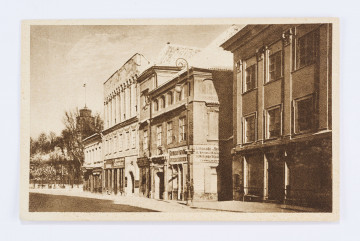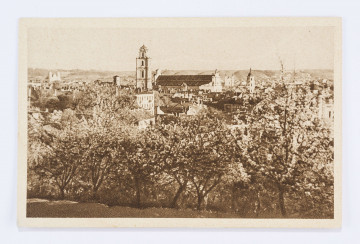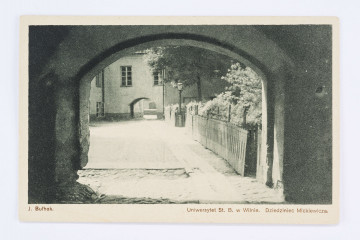
Postcard: Vilnius. View of Wielka Street and the Castle
1922 — 1939
National Museum in Lublin
Part of the collection: Photographs of Lublin
In 1972, the Capuchin Order was brought to Lublin, forty years after the congregation had settled in Poland. Lublin became the fourth seat of the convent in the Republic of Poland. The patron of the monks was Grand Marshal of Lithuania, Paweł Karol Sanguszko. The Sanguszkos owned a palace in Przedmieście, known as Krakowskie Street. Despite the objections of the Lublin bourgeoisie, they founded another church near the monastery, dedicated to Saints Peter and Paul.
The design of the sacral buildings was made by Karol Bay. The construction was supervised by his nephew, Jan. The entire project was completed in 1733. The façade of the church was decorated with statues of patron saints. The furnishings of the church and the roof were burnt down in a fire that broke out more than thirty years later. Reconstruction took years. The appearance of the church changed over time. In the first half of the 19th century the interior was decorated with sculptures by Władysław Oleszczyński, an artist of the Romantic period. A neo-Gothic chapel designed by Bolesław Podczaszyński was added to the eastern side of the church. It was founded by the would-be wife of the owner of the Samoklęska estate near Lublin. After her fiancé took his own life, "with all the irritation of a noble soul", wrote Maria Ronikierowa in the Lublin guide in 1901, "she became a nun [...] in Kraków". She donated the sum of money left by her fiancé in her will to the Capuchins in Lublin. Their monastery housed the state archive during the January Rising. After the fall of the uprising, the order was annulled. The remaining brothers were displaced to Łomża. They returned to Lublin only after Poland had regained independence.
At the end of the 19th century, the Lublin painter Władysław Barwicki painted a picture of the Crucified Christ and St Francis on the façade of the Capuchin church. Among the interesting relics from the church's equipment there is a painting of Sen Leszka Czarnego [The Dream of Leszek the Black] by an unknown author, illustrating the legend of the origin of the oldest parish church in Lublin - the now non-existent Parish Church.
Author / creator
Dimensions
cały obiekt: height: 14 cm, width: 9 cm
Object type
postcard
Technique
stamping
Material
paper
Creation time / dating
Creation / finding place
Owner
The National Museum in Lublin
Identification number
Location / status

1922 — 1939
National Museum in Lublin

1922 — 1939
National Museum in Lublin

1922 — 1939
National Museum in Lublin
DISCOVER this TOPIC
National Museum in Szczecin
DISCOVER this PATH
Educational path